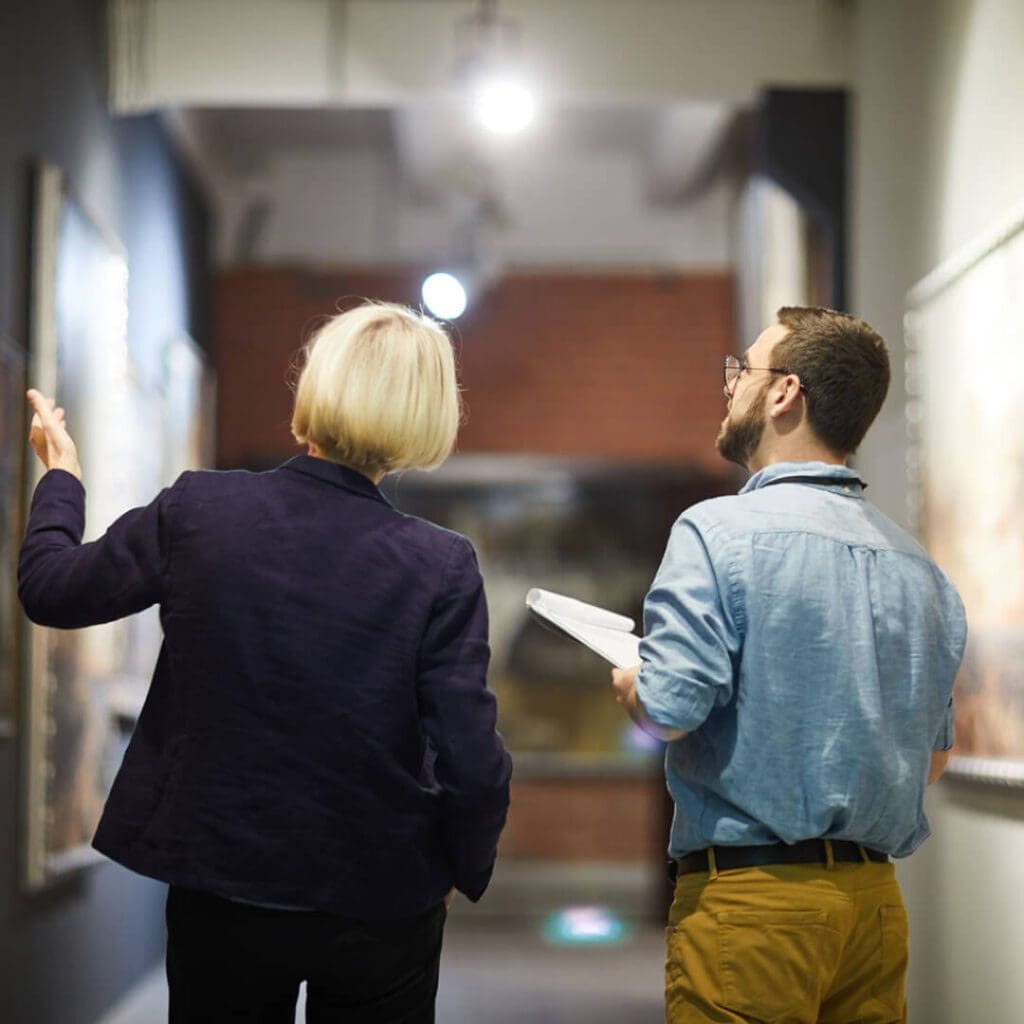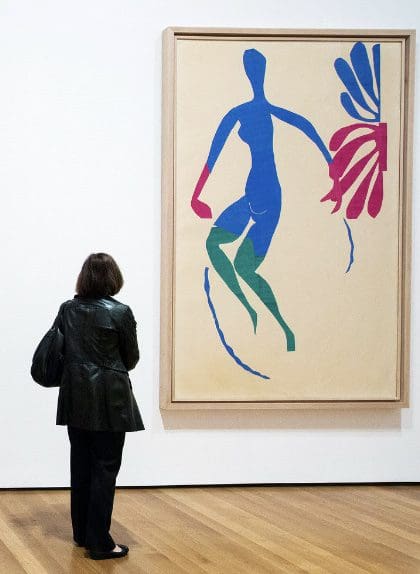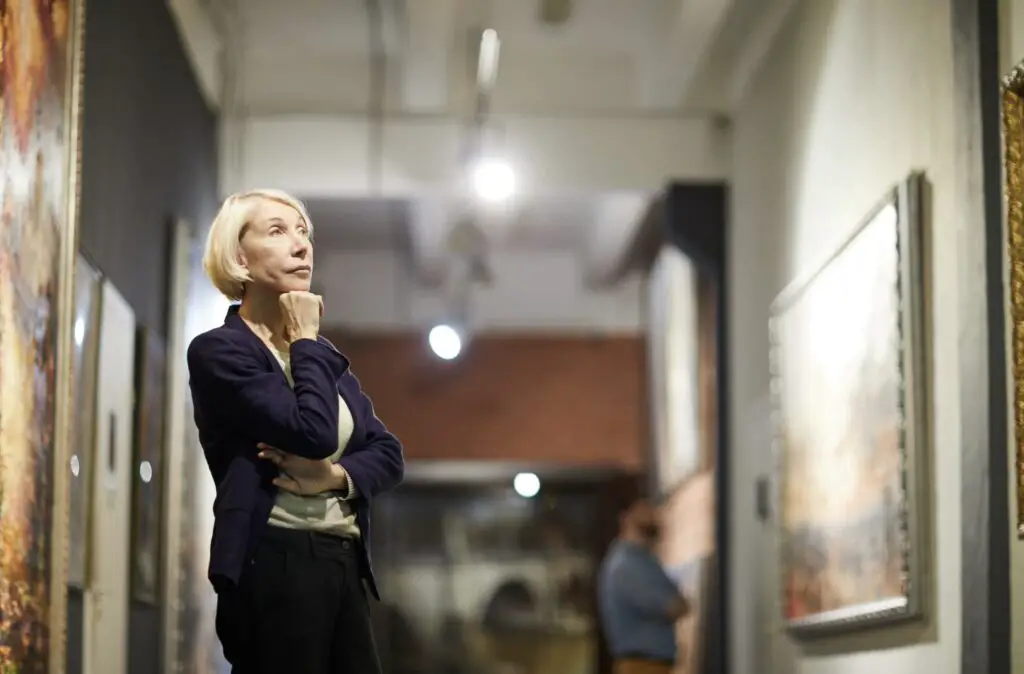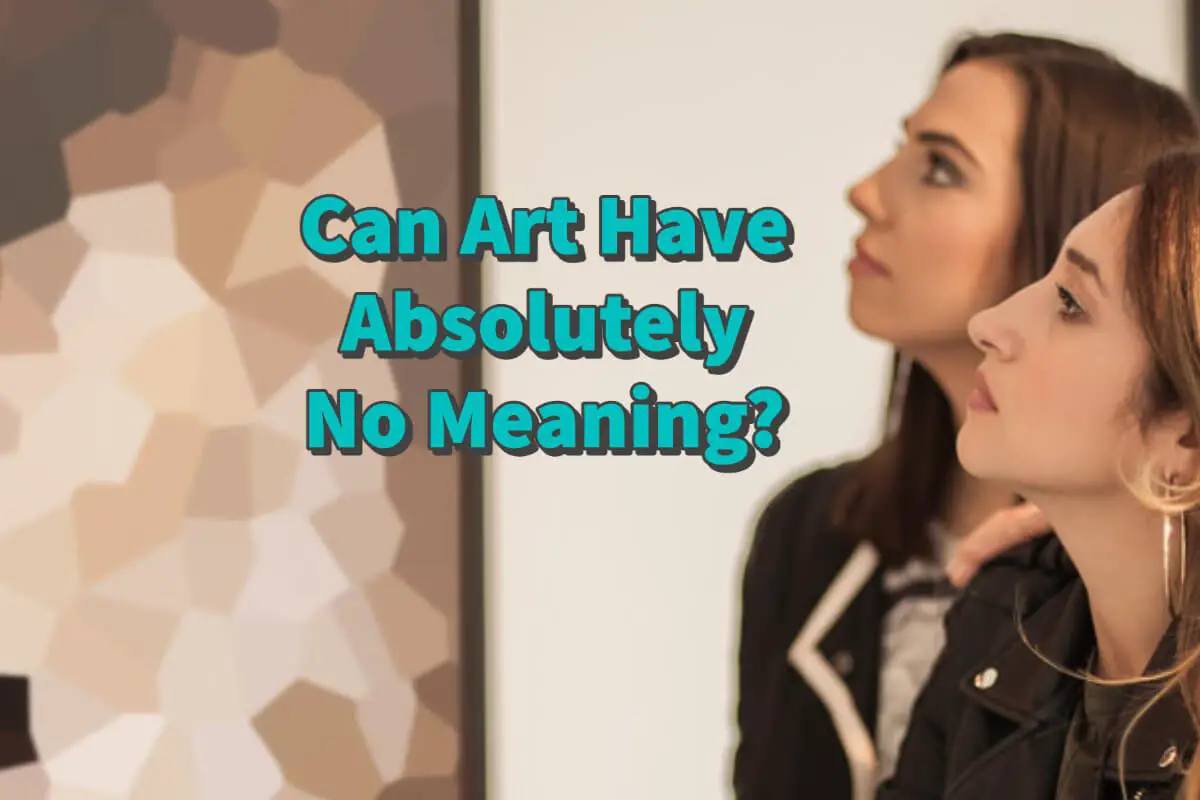Can art really have absolutely no meaning? Can art exist without meaning? These are some deep questions about art, philosophy, interpretations, the subconscious, and the meaning of art.
All art has some meaning; art can not exist with absolutely no meaning. This is because all human activity has some meaning, so even if the artist says the art has no meaning, the no meaning – is the actual meaning of the art. When a person views the art, their subconscious will give them an interpretation of the art.
Table of Contents
- Art With No Meaning Is A Meaning
- Communication Is Not Limited to Words
- Art and Interpretation
- Frequently Asked Questions
- Related Content
Art With No Meaning Is A Meaning
When an artist says that their artwork has no meaning – the no meaning – is their meaning. All human activity has some meaning. Just being near someone has a meaning, even if that person is sitting silently.
Silence is also a message when you are silently sitting next to someone. Many times, silence can be a more powerful message than if someone speaks.

The same is true with art; when an artist says their art has no meaning, the lack of meaning is the message. And that lack of meaning can be as powerful of a message if someone sat silently next to you,
Your subconscious creates a message when a person sits quietly next to you. Depending on the person’s situation, you may think of that person as rude, shy, quiet, unfriendly, or stupid.
The same is true with art; when we are told a piece has no meaning, we subconsciously create a message. We may sit there and view the art, but our subconscious mind will derive meaning from the work of art. In other words, we will see art as our subconscious views the art.
We will also put what we know or have experienced into our art viewing. Maybe the art is a blue and yellow spot on a canvas. Those blue and yellow spots may remind us and speak to us about blue skies and yellow flowers.
It may remind them of the Swedish flags, which are blue and yellow. For others, their childhood home had a blue door with a yellow bucket outside the door – so they see that in the blue and yellow canvas. All these are our subconscious giving meaning to the art because of our experiences, memories, or knowledge.
Even when artists say they are rebelling against the establishment and refuse to place a meaning on their art, that act of rebellion is the meaning; even artistic rebellion has a meaning.
All human activity has meaning. As human beings, our minds are programmed to look for and find the meaning – even if the meaning is not apparent. Just by human nature, our subconscious will make an artistic interpretation.
Communication Is Not Limited to Words
Our communication is not limited to our words. We can communicate in many ways: color, lack of color, texture, brush strokes, or lack of brush strokes, even words or a lack of words.
David Carson, the Graphic Designer, pointed out many ways art can communicate. David Carson said:
There’s many ways you communicate. With colour, texture, sound… Even words can communicate.
David Carson
What David Carson is saying here is that all art, all colors, all textures, and words is communication and have meaning. That is why art must always have some meaning and interpretations.

Art and Interpretation
When we view art, all of us will interpret the art. Two significant philosophies exist in how we view art: intentionalism and anti-intentionalism. Both of these have to do with how we see and view the work and interpret the artwork.
This theory of intentionalism and anti-intentionalism is usually relevant to literature or authors. But it is also suitable for visual art because the theories speak about how our subconscious interprets and adds meaning to any work of art – including visual art.
Here is how I see the philosophy of intentionalism and anti-intentionalism and our interpretation of art: why our subconscious places meaning in our interpretation of art.
Anti-Intentionalism and Art
Anti-intentionalism is how our viewing or interpretation of art is determined by what we know, feel, or experience. We are, in a sense, rejecting the artist’s intention. Instead, we are placing our own interpretation of the art. We see art completely through our own eyes and experiences.
We see in the art what we want and how we want to see it. We do not care what the artist’s intentions are; instead, we will derive our own meaning from the art.
Intentionalism and Art
Intentionalism is the opposite of anti-intentionalism; we view art how the artist wants it viewed or seen. We will align ourselves with the full intention of the artist.
When I took art history and viewed many classical paintings, the teacher told us not to interpret the artist’s works for ourselves as much as to understand the artist’s intention. What was his meaning? What was he trying to convey to us? What did each of those symbols mean, and why?

We would intentionally try to understand how the artist wanted us to view his works of art. That is intentionalism – viewing the art as the artist intended it to be considered.
The truth is that most people usually view art as anti-intentionalism and intentionalism. Our own knowledge, feelings, and experiences will influence how we see and view art. This is one of the gifts of art in that two people can see the same thing and come out with different interpretations and meanings.
So sorry, fellow artists – if you want to say that your art has no meaning, it does, and it will. We each view the art using our own subconscious and interpretations. When there is no meaning, we will randomly decide what that meaning is – our minds cannot help it!
Anita Louise Art – #ArtThatMakesYouSmile -we love all kinds of art.
Anita Louise Art is dedicated to art education, great artists, and inspiring others to find and create their art. We love art that uplifts and inspires. #ArtToMakeYouSmile! #ArtToMakeYouHappy!
If you are interested in seeing any of my art, you can find out more by clicking here. If you are interested in what inspires me and my paintings, you can discover more by clicking here.
We have a free newsletter and would love you to be part of our community; you can subscribe to the newsletter by clicking here. If you have any questions, I would be happy to talk to you. You can reach me, Anita, by clicking here.
Subscribe to our Anita Louise Art YouTube Channel filled with great videos and information by clicking here.
Join us for our podcast “5 Minutes With Art.” Spend just 5 minutes a week with us to discover and learn about great art and artists. You can find out more about our podcast by clicking here.
Frequently Asked Questions
Can art truly have absolutely no meaning?
Art, by its nature, reflects human expression and thought. Even seemingly meaningless art may convey subconscious or unintended messages. So, is it possible for art to have absolutely no meaning?
If an artist claims their work has no meaning, does that make it devoid of significance?
Even if an artist explicitly states that their work is meaningless, the very act of creating art imbues it with a certain meaning. Can art truly escape interpretation, or does the absence of intended meaning become a form of meaning itself?
How does the viewer’s subconscious contribute to the meaning of art?
Even when an artist claims their work is devoid of meaning, viewers bring their own experiences and perspectives to the interpretation. Can the subconscious mind of the observer assign meaning to art, even in the absence of the artist’s intent?
Is the absence of meaning a form of artistic rebellion or a genuine artistic choice?
Some artists deliberately create work that appears meaningless, challenging traditional notions of artistic intent. Is this a rebellious act against established norms, or is it a legitimate artistic decision that explores the boundaries of expression?
Does the concept of meaninglessness in art challenge the conventional definition of art itself?
If art is traditionally seen as a form of expression with inherent meaning, does the creation of art without meaning challenge the very essence of what is considered art? How does this redefine the boundaries of artistic practice?
Can the lack of apparent meaning in art be a commentary on the subjective nature of interpretation?
Could artists be using the absence of meaning as a commentary on the subjective and varied ways individuals interpret art? Is the intention to highlight the diverse meanings that viewers might derive from the same piece?
Is it possible for art to be meaningful solely on a sensory or aesthetic level?
If an artwork lacks explicit conceptual or narrative meaning, can it still hold significance on a purely sensory or aesthetic level? Does the emotional impact or visual experience become the primary source of meaning in such cases?
How does the cultural context influence the perception of meaninglessness in art?
The meaning attributed to art often depends on cultural and societal contexts. Does the idea of art having no meaning differ across cultures, and how does cultural background shape the interpretation of seemingly meaningless art?
Can randomness or chaos in art be considered a form of meaninglessness?
Art that appears chaotic or random may give the impression of lacking meaning. Can randomness itself be a deliberate artistic choice, and does the absence of a structured narrative or message contribute to the overall meaninglessness of the artwork?
Does the debate over meaning in art reflect broader philosophical discussions on existence and purpose?
The discourse around meaning in art extends into broader philosophical questions about existence and purpose. Does the discussion on whether art can have no meaning ultimately connect to larger debates about the nature of human consciousness and the purpose of creative expression?
Related Content
What Are The Pros and Cons of Selling Your Art In An Art Gallery?
When selling your art to an art gallery, consider many pros and cons. One of the major pros is that the gallery usually helps you to market your artwork. A major con is that you usually lose control over who buys your artwork. An artist needs to weigh out if selling through an art gallery is what they want to consider to sell their artwork.
You can learn more by reading our blog Pros and Cons Of Selling Your Artwork To An Art Gallery by clicking here.
What Are The Pros and Cons Of Selling Your Art At Art Fairs?
The Art Fair model of selling art is has been around for a long time. But with any method of selling your art, there are pros and cons if you choose to use the Art Fair as your main way to sell your art.
You can find out more by reading our blog Pros and Cons to Selling Your Art At Art Fairs by clicking here.


